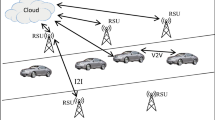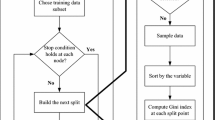Abstract
Sensor data, which is also accurate, is used in the bulk of studies on traffic-related data. The volume of this data, however, is insufficient to cover the majority of the road network due to the high cost. To get a complete and accurate range of data, image processing-based solutions with higher compatibility and ease of maintenance, as well as sensors, are necessary (Rakesh et al., Int J Sci Technol Res 8(12) (2019)). Free-flowing traffic is harder to detect and manage than dedicated lanes, and therefore necessitates more exact forecasting. A traffic analysis system based on the random forest algorithm is presented in this study, which predicts traffic congestion on a given road and notifies users well in advance.
Access this chapter
Tax calculation will be finalised at checkout
Purchases are for personal use only
Similar content being viewed by others
References
Yan G, Chen Y (2021) The application of virtual reality technology on intelligent traffic construction and decision support in smart cities. Wireless Commun Mobile Comput 2021. https://doi.org/10.1155/2021/3833562
Kaur J, Batra N (2014) A traffic aware health monitoring application embedded in smart ambulance (THESA). Int J Comput Sci Eng (IJCSE) 2(11):132–137
Batra N, Goyal S (2022) DDSS: an AI powered system for driver safety. Lecture Notes Netw Syst 339:429–437. https://doi.org/10.1007/978-981-16-7018-3_32
Sun D et al (2020) A highway crash risk assessment method based on traffic safety state division. PLoS ONE 15(1):e0227609
Feng C, Suren C, Ma X (2016) Crash frequency modeling using real-time environmental and traffic data and unbalanced panel data models. Int J Environ Res Public Health 13(6):609
Liu B, Sun Y (2011) Application and study on artificial intelligence technology in traffic signal control system. In: International conference on applied informatics and communication. Springer, Berlin, Heidelberg
Šusteková D, Knutelska M (2015) How is the artificial intelligence used in applications for traffic management. Mach Technol Mater 9(10):49–52
Rakesh S, Hegde NP (2019) Automatic traffic density estimation and vehicle classification method using neural network. Int J Sci Technol Res 8(12). ISSN 2277–8616
Pozanco A, Fernández S, Borrajo D (2016) Urban traffic control assisted by AI planning and relational learning. ATT@ IJCAI
Elish MC, Boyd D (2017) Situating methods in the magic of big data and artificial intelligence. Commun Monographs, Forthcoming
Raja J, Bahuleyana H, Vanajakshia LD (2014) Application of data mining techniques for traffic density estimation and prediction. In: 11th Transportation planning and implementation methodologies for developing countries, TPMDC 2014, Mumbai, India
Rabby MKM, Islam MM, Imon SM (2020) A review of IoT application in a smart traffic management system. Int J Eng Appl Sci Technol 5(1):612–615(2020). ISSN No. 2455–2143. https://doi.org/10.1109/ICAEE48663.2019.8975582
Regassa AA, Feng WZ (2021) Prediction of road traffic concentration using random forest algorithm based on feature compatibility. Int J Eng Res Technol (IJERT) 10(4), ISSN: 2278–0181
Aydin S, Taşyürek M, Öztürk C (2021) Traffic density estimation using machine learning methods. J Artific Intell Data Sci (JAIDA) 1(2):136–143. e-ISSN: 2791–8335
Author information
Authors and Affiliations
Corresponding author
Editor information
Editors and Affiliations
Rights and permissions
Copyright information
© 2023 The Author(s), under exclusive license to Springer Nature Singapore Pte Ltd.
About this paper
Cite this paper
Batra, N., Goyal, S. (2023). Real-Time Smart Traffic Analysis Employing a Dual Approach Based on AI. In: Mahapatra, R.P., Peddoju, S.K., Roy, S., Parwekar, P. (eds) Proceedings of International Conference on Recent Trends in Computing. Lecture Notes in Networks and Systems, vol 600. Springer, Singapore. https://doi.org/10.1007/978-981-19-8825-7_61
Download citation
DOI: https://doi.org/10.1007/978-981-19-8825-7_61
Published:
Publisher Name: Springer, Singapore
Print ISBN: 978-981-19-8824-0
Online ISBN: 978-981-19-8825-7
eBook Packages: Intelligent Technologies and RoboticsIntelligent Technologies and Robotics (R0)




